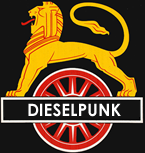 THE GATEHOUSE
THE GATEHOUSE
Welcome to the DIESELPUNK section of The Gatehouse. The term “dieselpunk” was first coined to describe a darker, dirtier side of steampunk, informed by cyberpunk sensibilities, set in a post-steampunk era with a higher industrial level of development. Like steampunk colonizes the past of Victorian-Edwardian Scientific Romances and Voyages Extraordinaires with the present, dieselpunk transports modern-day technologies and attitudes into the era of mid-century pulp fiction—pulp refering to the inexpensive fiction magazines widely published from the 1920s through the 1950s, typically remembered for their sensational and exploitative stories and thrilling cover art.
Like steampunk exists within the framework of speculative fiction, dieselpunk resides under the banner of Pulp, specifically characterized by the rise of petroleum power and technocratic perception, incorporating neo-noir elements and sharing themes with Adventure Pulp.
Please select one of the titles listed below to proceed to your article of choice.
• “The darker, dirtier side,” by N. Ottens (2008)
In which we seek to define the genre of dieselpunk by studying its major influences and proposing several characteristics typical of dieselpunk fiction.• “Quintessential Dieselpunk,” by N. Ottens (2008)
In which we further scrutinize the features of the genre by examining a number of its quintessential works of fiction.• “Two Flavors of Dieselpunk,” by N. Ottens (2008)
In which we introduce the two proposed categories of dieselpunk: the optimistic “Ottensian” and the dark, sometimes post-apocalyptic “Piecraftian”.• “What’s Biopunk?,” by N. Ottens (2008)
In which we discuss the history and characteristics of the proposed sub-genre of biopunk to ascertain whether it is a separate genre.
